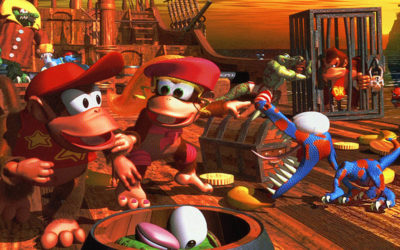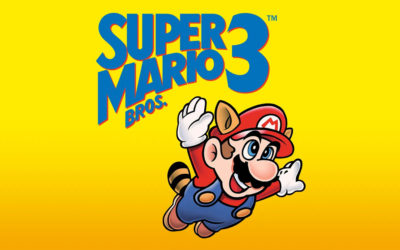Monkey.
That was the only name we had for Donkey Kong in my house prior to November, 1994. My brother and I knew the smelly, singlet-wearing animal from 1992’s Super Mario Kart was known, canonically, as Donkey Kong Jr., but we never once would waste the electrical signals required to utter that name. Monkey was big, dumb, and threw bananas that he usually ran straight into on the bumpy Choco Island courses. We called Bowser “Thunderbutt,” and Toad was lovingly nicknamed “Turd,” but Monkey earned the most groans of ire.
At the arcades, we would sometimes happen across older Donkey Kong cabinets. We were of the House of Mario above all other mascots, and we recognized the origin story. However, once you’ve played the first three Super Mario Bros. titles and journeyed yourself into Super Mario World, the bonky joystick-controlled Jumpman just didn’t feel right. Donkey Kong arcade was quaint. Respected and groundbreaking, but quaint.
Who would have thought that the Throwaway Hominidae would eventually become the Papilla-headed Gorilla in one of gaming’s most brightest glow-ups of the 16-bit era.
The advertisements may have helped?
Then again, maybe not.
Grafficks!™ were all the rage at the time, and being able to cram more than a dozen-or-so colors on the screen was still pretty new. The bananas in this game were rumored to have a whopping sixteen shades of yellow in them! Radical, man!
The sprite work was rendered using the same technology that brought the dinosaurs in Jurassic Park to life. Rare dug up fossilized mosquitoes that contained gorilla blood and mixed it with crocodile DNA and before you know it, we had Donkey Kong Country. Wait, no, they used 3-D models. The game itself isn’t actually 3-D, but 3-D was the big buzzword at the time. The method used to generate the sprites (the two-dimensional pixel-based images that form the characters and items in the game) allowed the developers to make the animations look buttery smooth. Of course, they didn’t need to utilize cutting-edge 3-D modeling and animation to achieve this result – any animator and game developer could sit down together and create a 20-frame walk cycle. Apparently the use of expensive super computers made this more cost effective.
I’ll talk about the visuals a little more when I get to the review.
I didn’t buy many games at launch when I was a kid. I normally had to wait until Christmas, but 12-year-old Lynk managed to get Donkey Kong Country within a couple days of its release with his own cash money.
Donkey Kong Country was a game changer. Besides looking far more advanced than most other games, it broke the fourth wall in a way that pulled back the curtains of video games for me.
You see, the titular Donkey Kong in Donkey Kong Country is supposedly Donkey Kong Jr. (or Donkey Kong Jr.’s son, depending on which instruction booklets you read). The Donkey Kong from the Donkey Kong arcade game who terrorized a very Popeye-looking Mario grew old and became Cranky Kong.
Cranky spent a good portion of his time busting on modern video games. The instruction booklet had commentary from the old ape about the simpler times of gaming, and Cranky did a fair share of player-trolling too. It was the perfect introduction to a world that is otherwise very off-brand if you were to assume that Donkey Kong Country was still in the same world as Super Mario. Young Lynk, who was quickly growing into a troll himself, ate this type of satirical commentary up like Jaffa cakes.
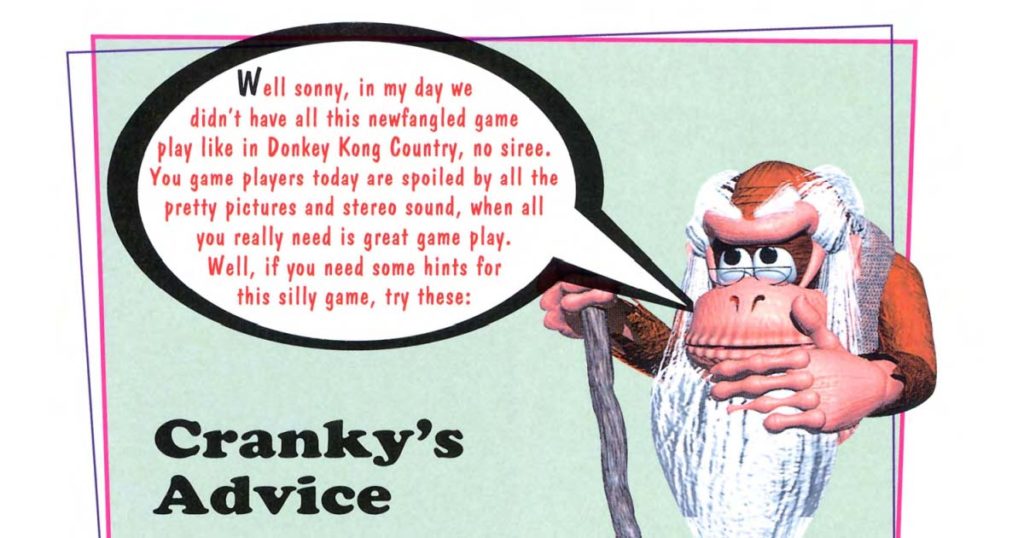
A little over a decade out of the limelight can really take a toll on a gorilla, I guess. All things considered though, the old coot has a point that still rings true today.
Donkey Kong Country (and its sequels, and its eventual return with the obviously titled Donkey Kong Country Returns) would go on to be one of my most beloved franchises. In fact, I typically end up giving the original trilogy on the SNES a playthrough ever couple of years. This time though, I tried to look at Donkey Kong Country with a more skeptical eye. Did Rareware and Nintendo hit it out of the park, or did the hype of 3-D graphics get caught into my nostalgiathalamus in a feedback loop?
Let’s review.
Visuals
While little can be said for the promotional art renders, other than it was the early 90’s and we were still figuring out how shiny to make things, Donkey Kong Country really did milk a lot of fancy visuals out of the Super Nintendo. This is mostly due to every element in the game being pre-rendered in 3-D. This means the backgrounds, the items, the characters, and even the UI elements were rendered in the same software used to create Hollywood-level computer graphics at the time, and then “cut out” into two-dimensional images.
The end result? It’s not bad. It certainly has a very distinct look, and for the time, the visual style felt new and cutting edge.
Today, it’s easy to see the shortcomings that the 90’s were dealing with, but it’s also incredible to notice the little touches that Rareware kept adding to the game to take things to the next level.
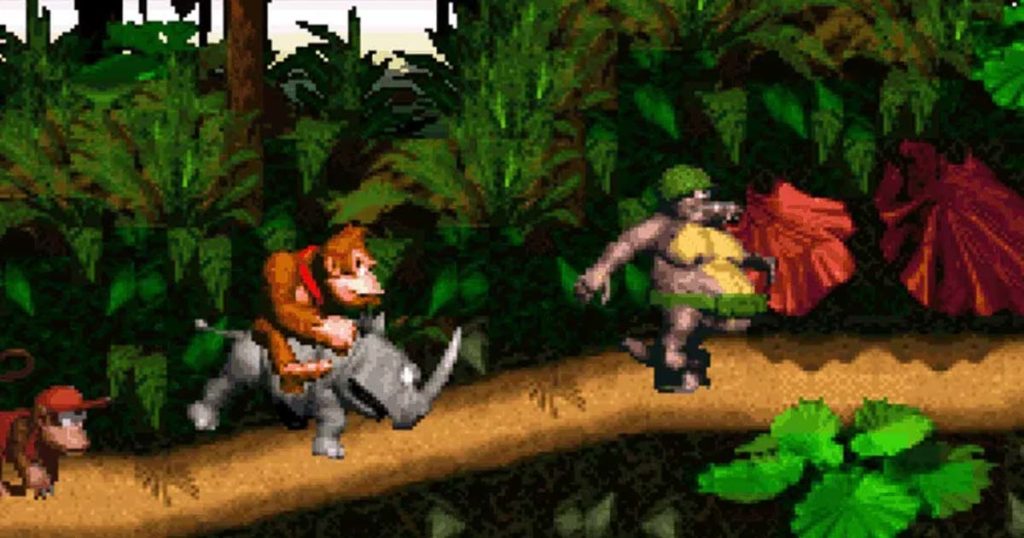
A screenshot doesn’t really do the game justice – you have to see it in motion.
Notice as the stage progresses, at about 40 seconds in, snow starts to come in from the background, until it is in the foreground. This is done in a few stages, and the biggest transition triggers when there is a lot of movement.
Today, the visual style of Donkey Kong Country wouldn’t turn heads, but little touches here and there make the game much more interesting and much more visually impressive.
There are plenty of odd graphical glitches and obvious limitations to the hardware and software of the time, but it never really takes away from the gameplay. It’s not beautiful, but it’s functional, and it’s absolutely ambitious. I think I’d settle on calling it a style-choice, much like Wind Waker’s cell-shading is a style-choice, love it or hate it.
There are portions where the visuals are a little off-putting. I’m talking to you, beaver-stamped-onto-a-stone-wheel…
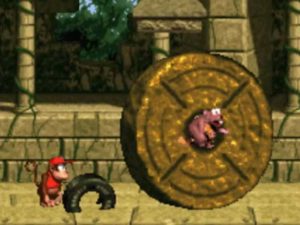
Otherwise, I’d say they work. It’s definitely not worth getting upset over them. Except that beaver-wheel.
Audio
The soundtrack compliments the visuals. Whereas the pre-rendered 3-D graphics looked far and beyond typical sprite work from the first half of the 90s, the music and ambient sound was even further ahead of its time. Some level sets have complex tracks that grow and layer percussion with sounds of nature, only to break out into a catchy swing, while others use synth loops to set the mood that fits the stage.
The sound effects are otherwise fine. The light plunk of collecting a banana to the frantic monkey noises are iconic. Everything, for the most part, falls into place. The only real gripe I have is the sound the Kongs make when they hit the ground after a jump. It doesn’t change depending on the surface, and it’s otherwise the only footfall sound.
Oh, and for some reason, I really liked the sound the klaptrap’s jaw made when I was younger. For some reason, it just sounded so realistically mouthy to me as a lad that I was disappointed it never made it back into the series.
Gameplay
This is where Rareware and that ol’ Nintendo polish really shine. The controls feel good. The movement was fluid. Donkey Kong Country uses traditional platformer controls. You walk, you jump, you have an attack, and when you hold down the attack button while moving, you run. Your attack propels you forward slightly, giving you momentum into the run. While holding the attack/run button, you can also lift up barrels, and then release the button to throw them at enemies. The characters do feel a little slippery, especially around edges of platforms, but otherwise maneuvering feels very normal and natural.
You play as both Donkey Kong and Diddy Kong. Both characters handle essentially the same, but Diddy is smaller and a little faster, while Donkey can usually defeat larger enemies easier. If you get hit, the active character runs off into the jungle leaving you alone with the remainder. If you only have one monkey and take damage, you lose a life fade to black. You can bring your buddy back by breaking barrels with the DK logo on the side. You can usually hear these barrels even if they are slightly off screen, which is a real nice touch.
You progress through levels, which are mostly very linear, bouncing off enemies, collecting bananas and other items, and avoiding pitfalls. You simply progress through the level until you get to the end, and move on to the next.
Hidden in most levels are secrets. Typically these are caves that need to be revealed by smashing a barrel into a wall, or cannon barrels you need to jump into. You can finish the game without discovering any or all of the secrets, but if you can find them all, your save file will show a 101% completed status.
This mechanic would define the whole series and gives the game a lot of replayability to hunt down these secret areas.
Many levels introduce a standalone gimmick that is explored as you progress through the stage. This might include turning lights on and off to force you to make blind jumps, to the infamous mine cart levels that leave you to rely on fast reflexes (or, less satisfying, trial and error in some cases). These gimmicks add welcome variety to the stages and keep the game fresh, although some are much more enjoyable than others.
Multiplayer
Donkey Kong Country offers a pretty standard fare for co-op play, considering it’s a 2-D platformer in the mid-90s. You can either play competitively, where each player goes through the game separate of each other, taking turns when one player completes a stage or dies trying, or you can play cooperatively, where one person is Donkey Kong, and the other is Diddy. Both players don’t play at once, however. You have to either manually switch the active monkey, or wait for the other player to screw up to get your turn. It’s a little less than ideal for a big-brother-little-brother situation.
Accessibility
Donkey Kong Country is pretty accessible, especially if you are used to 2-D platformers. The controls could be tighter, but maneuvering is natural. The game isn’t especially difficult, but there are certainly areas that are pretty demanding. Oddly, the difficulty curve shoots up pretty fast for the second level, which contains armadillo enemies that are both fast and require two hits to dispatch with Diddy. You often have little warning that they are rolling their way towards you, and I’ve seen that frustrate a lot of novice players. That stage should be a little further into the game.
Otherwise, Donkey Kong Country is pretty forgiving. Stages tend to be short, and extra lives are plentiful.
Replayability
I loved Donkey Kong Country from day one, and I’ve replayed it all the way through more than half a dozen times in my life. I’d say that makes it replayable. What I have noticed is that, while I do have a fondness for the game and the series in general, the first one doesn’t hold up as well as the sequel. It’s definitely worth playing and worth revisiting. It’s not a long game, by any means – one could finish it in a few hours. It might take longer to hunt down all of the secret areas if it is your first time, but that’s half the fun.
Donkey Kong Country is a first step into what has become a milestone series, and redefined the 2-D platformer genre with cutting-edge (but not future-proof) visuals, great music, and solid gameplay that crosses the boarder between simple to experimental. Rareware and Nintendo accomplished what they set out to do; squeeze a few more years out of their Super Nintendo without a hardware refresh, and bring an almost forgotten mascot back into the limelight.
It’s a straightforward game that, as a whole, works very well despite flaws and paved a path for something greater. The final boss, a very fat crocodile pirate king, is a whole lot of fun and tops the game off with a cherry. It feels really good to complete Donkey Kong Country.
It’s hard to talk about Donkey Kong Country without mentioning the amazing sequel, Donkey Kong Country 2: Diddy’s KONG-quest. Trust me, that review is coming. The sequel does everything to improve upon the first, but it’s certainly worth checking out the game that started it all.
Donkey Kong Country (SNES)
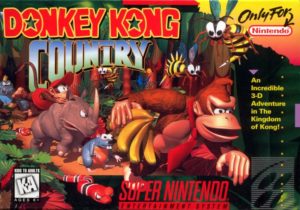
Game title: Donkey Kong Country (SNES)
Game description: Donkey Kong Country originally came out for the Super Nintendo in November, 1994. The game has also been ported to the WiiU, 3DS, Super Nintendo Classic Mini, and is now available on the Nintendo Switch Online Super Nintendo library. Ports were also developed for the Gameboy Color and Gameboy Advance. It is the third bestselling SNES game, with 9.3 million copies sold worldwide.
Author: Rareware/Nintendo
-
Visuals - 7/10
7/10
-
Audio - 8.5/10
8.5/10
-
Gameplay - 8/10
8/10
-
Accessibility - 7.5/10
7.5/10
-
Replayability - 9/10
9/10
Donkey Kong Country is Lynk Approved
It’s a technical marvel, even if the edges could be a little more polished.
I’ve played and beaten this game over half a dozen times. I recently replayed it on the Nintendo Switch, beating all 40 stages and finding all of the secret areas in about 3 or 4 hours. It’s a game that has worn slightly over the years for me, but I’m sure I’ll pick it up and play it again someday.
Pros
- Fast, fluid, fun controls.
- Amazing soundtrack.
- Fun gimmicks and quirks as you progress.
- Great final boss fight.
- It’s still pretty, despite the rough edges.
Cons
- Sometimes, enemy placement/camera movement is a little unfair.
- Some gimmicks work better than others.
- Candy Kong is too hot.


